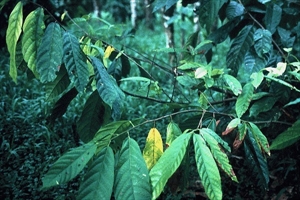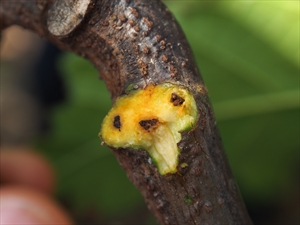Cocoa vascular streak dieback
Pacific Pests, Pathogens and Weeds - Online edition
Pacific Pests, Pathogens & Weeds
Cocoa vascular streak dieback (223)
Oncobasidium theobromae
Asia, Oceania. It is recorded only from Papua New Guinea.
Cocoa and avocado
The first signs of the disease are scattered green spots against a yellow background on one or two leaves up to 1 m behind the shoot tip (Photo 1). After a few days the leaves fall, and those leaves above and below begin to show similar symptoms. Lenticels grow larger, giving the bark a rough appearance, and axillary buds develop (Photo 2), but after about 20 cm growth, they die. If the surface layer of the leaf scar is scraped away, three small dark areas can be seen which are the ends of the diseased vascular tissues (the cells that transport nutrients and water up and down the stems and branches). Growth of the diseased shoot slows, symptoms spread to the other branches and the tree dies. White spore-producing bodies ('sporophores') form from the leaf scars (Photo 3).
A feature which is characteristic of the disease, and the reason for its name, is seen when the stems are split open - a brown streak is present in the vascular tissues for several cms above and below the scar where a leaf (or leaves) has fallen.
Spread of the fungus is by spores released from the sporophores at night and blown in the wind. However, for sporophores to develop, leaf fall has to occur during wet weather, and this and the fact that sporophores do not last long, means that the rate of spread of the disease is relatively slow. It seems likely that the spores infect young unhardened leaves, possibly above the veins and, after 3-5 months, symptoms occur on the leaves that by now are some distance behind the shoot tip, as the branch has grown in the meantime.
This is a very destructive disease, especially on seedlings within the first year of planting in the field. At this time, the stems are susceptible to infection by the fungus leading to death of the plants. In Papua New Guinea and Malaysia, there are reports of 100% death of seedlings. On older trees, damage depends on the variety and how susceptible it is to the disease, with only rare instances of death.
Look for the presence of yellow leaves, often in the middle of a branch; also look for the development of buds and look for the swollen lenticels - lenticels are thin openings in the stem for exchanging gases between the plant and the environment. Look at the leaf scars; remove the surface layers and look for the three discoloured vascular tissues (Photo 4), and on others look for white spore-producing areas.
Examine cross sections of stems under a microscope to check for fungal strands in the water-conducting vessels - the xylem.
QUARANTINE
Countries not yet infested by cocoa vascular streak dieback should take special precautions against its introduction. Similarly, plants should not be sent from infested to healthy areas within the same country; plants should go into quarantine for 3 months.
The FAO/IBPGR Technical Guidelines for the Safe Movement of Cacao Germplasm (Revised 2010) should be followed (http://www.bioversityinternational.org/e-library/publications/detail/technical-guidelines-for-the-safe-movement-of-cacao-germplasm/). The shipping of whole pods is not recommended. In general, germplasm should be obtained from an intermediate quarantine station where pathogen testing is possible.
CULTURAL CONTROL
Pruning has been tried to reduce the level of disease in plantations, and to stop disease spread, but it is usually only effective on varieties with some resistance.
RESISTANT VARIETIES
The variety Amelonado is susceptible, but many hybrids are available from breeding programs in Papua New Guinea and elsewhere, so that now the disease is of little importance if they are used.
CHEMICAL CONTROL
Protectant fungicides are ineffective, and some of the systemic products damage cocoa. In any case, fungicides are likely to be uneconomic, especially for smallholders.
AUTHOR Grahame Jackson
Information (and Photo 1) from CABI (2012) Oncobasidium theobramae Crop Protection Compendium. (https://www.cabi.org/cpc/datasheet/37439); and from End MJ, et al. (Eds.) 2017. Technical guidelines for the safe movement of cacao germplasm. Revised from the FAO/IPGRI Technical Guidelines No. 20 (Third Update, October 2017). Global Cacao Genetic Resources Network (CacaoNet), Bioversity International, Rome, Italy. (https://www.cacaonet.org/fileadmin/templates/CacaoNet/Uploads/publications/Safe_Movement_Guidelines_2017_En.pdf). Photos 2&3 Chris Prior, Royal Horticultural Society, Wisley Laboratory, UK. Photo 4 Richard Markham, ACIAR, Canberra.
Produced with support from the Australian Centre for International Agricultural Research under project PC/2010/090: Strengthening integrated crop management research in the Pacific Islands in support of sustainable intensification of high-value crop production, implemented by the University of Queensland and the Secretariat of the Pacific Community.







